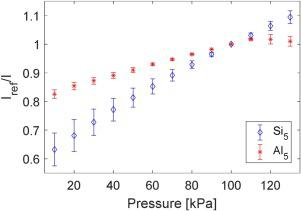Sensors and Actuators A: Physical ( IF 4.1 ) Pub Date : 2020-11-25 , DOI: 10.1016/j.sna.2020.112359 Steven Claucherty , Hirotaka Sakaue

|
Optical measurement techniques are being employed more frequently in unsteady aerodynamic testing. One of these techniques is unsteady pressure-sensitive paint (PSP), used to capture global surface pressure measurements at sampling rates on the order of kilohertz or faster. Polymer ceramic PSP (PC-PSP) is often used for these applications due to its porous structure and increased oxygen diffusivity. A limiting drawback of current luminescent markers used in unsteady PSP is that they have non-negligible temperature dependency, which is a major source of measurement uncertainty. Chemical sensor development is needed to create a sensor with reduced or negligible temperature dependency. This study investigates the development and characterization of a PC-PSP with reduced temperature dependency due to the use of pyrene sulfonic acid as the luminophore, a novel application for this luminescent marker. This study examines the influence of particles and the solvent used to apply the luminescent chemical and particles onto a model in the dipping deposition method on sensor performance. The chemical interaction between these sensor elements, as well as the luminophore and binder material, largely determines the performance of the sensor. Static calibrations were performed from 10 to 120 kPa and 20–80 °C, with a resulting peak pressure sensitivity of 0.4 %/kPa and minimum temperature dependency of 0.3 %/°C using silica gel porous particles. This resulted in an uncertainty in pressure due to change in temperature of 0.75 kPa/°C, an almost 40 % reduction compared to the closest comparison sensor. Dynamic characterization also showed response times on the order of 40-80 μs, which compares well with current PC-PSP sensors.
中文翻译:

使用pyr磺酸进行不稳定表面压力测量的光化学传感器
在不稳定的空气动力学测试中,更频繁地采用光学测量技术。这些技术之一是不稳定的压敏涂料(PSP),用于以千赫兹或更快的采样率捕获总体表面压力测量值。聚合物陶瓷PSP(PC-PSP)由于其多孔结构和增加的氧扩散性而经常用于这些应用。在不稳定的PSP中使用的当前发光标记的一个局限性缺点是它们具有不可忽略的温度依赖性,这是测量不确定度的主要来源。需要化学传感器的开发来创建具有降低的或可忽略的温度依赖性的传感器。这项研究调查了由于使用of磺酸作为发光体而降低了温度依赖性的PC-PSP的开发和表征,该发光标记的新应用。这项研究研究了在浸渍沉积方法中,将颗粒和用于将发光化学物质和颗粒施加到模型上的溶剂对传感器性能的影响。这些传感器元件之间的化学相互作用以及发光体和粘合剂材料在很大程度上决定了传感器的性能。使用硅胶多孔颗粒,在10至120 kPa和20–80°C的温度范围内进行了静态校准,因此峰值压力灵敏度为0.4%/ kPa,最小温度依赖性为0.3%/°C。由于温度变化0.75 kPa /°C,导致压力不确定,与最接近的比较传感器相比,降低了近40%。动态表征还显示了大约40-80μs的响应时间,











































 京公网安备 11010802027423号
京公网安备 11010802027423号